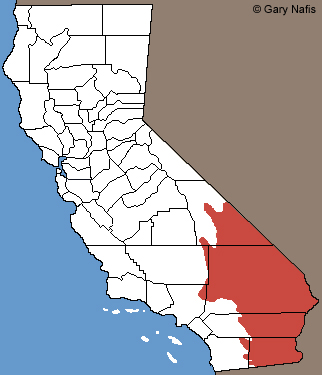|
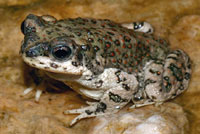 |
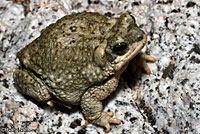 |
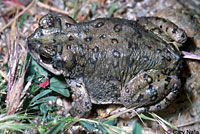 |
| Adult male on breeding pond making advertisement calls, San Diego County |
Adult, San Diego County |
Adult, San Diego County |
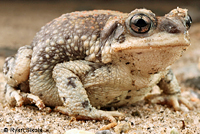 |
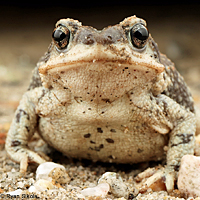 |
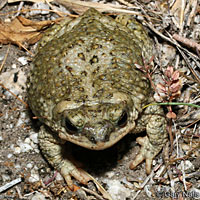 |
| Adult, Riverside County © Ryan Sikola |
Adult, San Diego County |
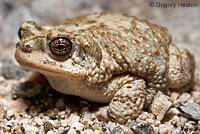 |
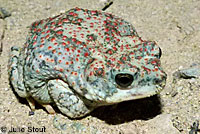 |
|
Adult, San Diego County
© Grigory Heaton |
Sub-adult, Imperial County
© Julie Stout |
|
| |
|
|
| California Juveniles |
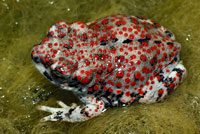 |
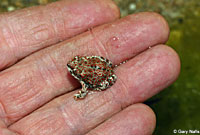 |
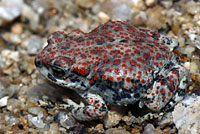 |
Recently-metamorphosed juvenile approx. 3/4 inches in length ( 2cm ) Riverside County
|
| |
|
|
| Adult Red-spotted Toads From Outside California |
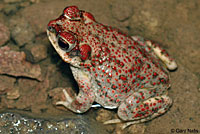 |
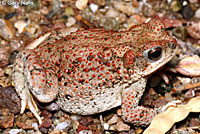 |
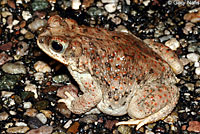 |
| Adult, Santa Cruz County, Arizona |
Adult, Pima County, Arizona |
Adult, Pima County, Arizona |
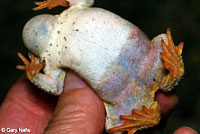 |
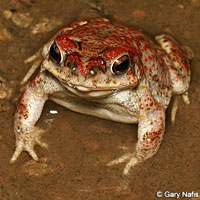 |
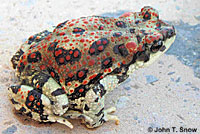 |
Underside of adult,
Pima County, Arizona |
Adult, Santa Cruz County, Arizona |
Adult, Cape Region, Baja California Sur
© John T. Snow |
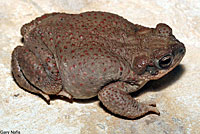 |
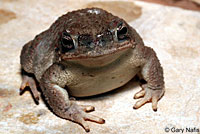 |
|
Adult, Brewster County, Texas
|
|
| |
|
|
| Juvenile Red-spotted Toads from Outside California |
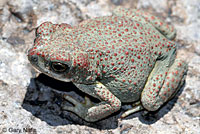 |
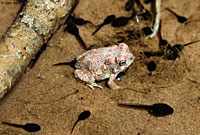 |
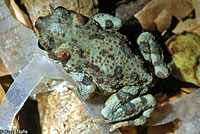 |
| Juvenile Brewster County, Texas |
Recently-metamorphosed juvenile, Washington County, Utah |
Juvenile, Agua Caliente,
Baja California Sur |
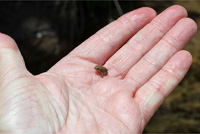 |
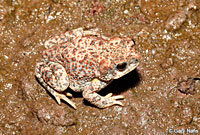 |
 |
| Recently-metamorphosed juvenile, Santa Cruz County, Arizona. |
Recently-metamorphosed juvenile, Santa Cruz County, Arizona. |
Recently-metamorphosed juvenile, Washington County, Utah |
| |
|
|
| Breeding, Eggs, and Tadpoles |
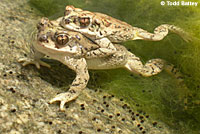 |
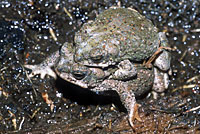 |
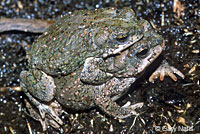 |
| Male and female in amplexus, with eggs on bottom of pool, San Bernardino County © Todd Battey |
Adults in amplexus, male on top, female on bottom, San Diego County |
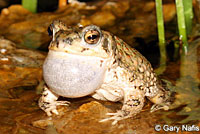 |
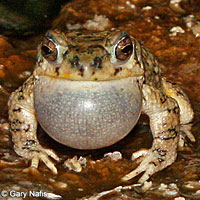 |
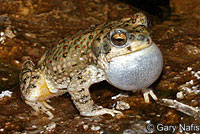 |
| Adult male calling at night, sitting on a mat of vegetation on a small pond in San Diego County |
Adult male calling at night,
San Diego County |
Adult male calling at night,
San Diego County |
| |
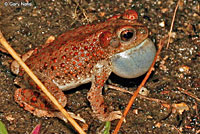 |
|
| |
Adult male calling at night,
Pima County, Arizona |
|
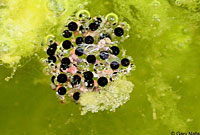 |
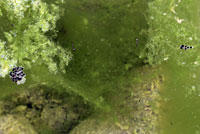 |
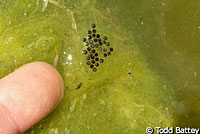 |
| Red-spotted Toads lay their eggs singly or in a small cluster. Other North American toads lay their eggs in strings. |
Two small egg clusters on aquatic vegetation at the surface of a small pool in a desert wash in Yavapai County, Arizona. |
Eggs, San Bernardino County
© Todd Battey |
 |
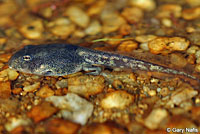 |
| Tadpole in water, Riverside County |
Tadpole in a shallow puddle,
Riverside County |
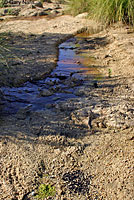 |
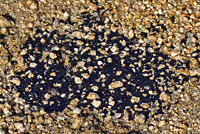 |
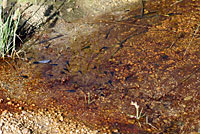 |
| Tadpoles stranded in evaporating water from the overflow of a desert oasis spring, Riverside County. The small black patch at the bottom of the picture on the left is the same group of tadpoles shown close-up in the picture on the right. Most of these tadpoles were still alive, so the water had only recently dried up and stranded them, probably dooming them to desiccation. |
Tadpoles in the overflow of a desert spring, Riverside County |
| |
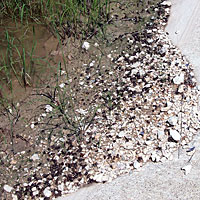 |
|
| |
Many tiny recently-transformed juvenile Red-spotted toads at the edge of a road culvert pool, Terrell County, Texas
|
|
| |
|
|
| Habitat |
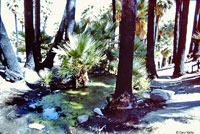 |
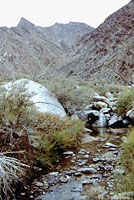 |
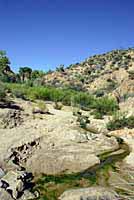 |
Habitat, San Diego County -
close-up of spring in desert palm oasis |
Habitat, San Diego County
desert creek |
Habitat, Riverside County,
runoff from desert spring |
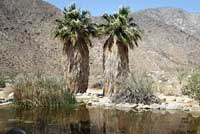 |
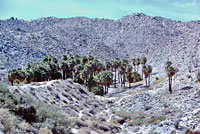 |
|
| Breeding habitat, San Diego County |
Habitat, San Diego County
desert palm oasis
|
|
| |
|
|
| Short Videos |
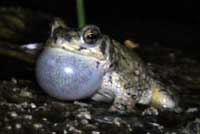 |
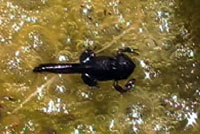 |
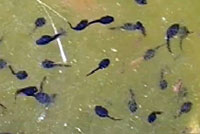 |
| A male Red-spotted Toad calls at night in San Diego County. California Treefrogs are calling in the background. |
Tiny toadlets still transforming from tadpoles crawl around on a mat of algae in a desert pond in San Diego County.
|
Red-spotted Toad tadpoles in a small desert pond in San Diego County |
| |
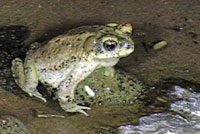 |
|
| |
Several calling male Red-spotted toads at night in a desert creekbed in Yavapai County, Arizona, refuse to call while the camera lights are on them. |
|
| |
|
|
|
Description |
| |
| Size |
Adults are 1.5 - 3 inches from snout to vent ( 3.8 - 7.6 cm). (Stebbins, 2003)
|
| Appearance |
A small toad with dry, warty skin, a flattened head and body, and a pointed snout.
Cranial crests are weak or absent.
Parotoid glands are round and about the size of the eye.
Pupils are horizontal.
|
| Color and Pattern |
Olive, brownish, light gray above, with red or orange warts, which give this toad its name.
White or cream below with or without spotting.
|
| Male/Female Differences |
| Male throat is darkened, female throat is pale. |
| Young |
| Young have many red warts with yellow under the feet. |
| Larvae (Tadpoles) |
Tadpoles begin as black with bronze flecks on the venter, then become black with faint light mottling.
|
| Life History and Behavior |
| Activity |
Nocturnal, remaining underground or underneath surface objects during daylight, but occasionally seen moving about in daylight or resting at the edge of breeding pools in the breeding season.
In arid regions, toads probably do not move far from water sources.
Presumably hibernates during winter cold and during dry periods.
|
| Movement |
Slow moving, often using a walking or crawling motion along with short hops.
A good climber, easily climbing over rocks. |
| Defense |
| As most toads do for defense, this toad relies on parotoid glands and warts which can secrete a poison that deters some predators. |
Territoriality
|
| Males defend breeding territories, wrestling and amplexing other males who come in to their territory. |
| Longevity |
| Longevity is under 6 years, averaging about 2 years. (Lannoo, 2005) |
| Voice (Listen) |
| This toad's call is a prolonged loud high-pitched musical trill, lasting up to 10 seconds, which is produced at night . |
| Diet and Feeding |
Eats a wide variety of invertebrates.
Prey is located by vision, then the toad lunges with a large sticky tongue to catch the prey and bring it into the mouth to eat. |
| Reproduction |
Reproduction is aquatic.
Fertilization is external, with the male grasping the back of the female and releasing sperm as the female lays her eggs.
Amplexus is axillary - the male grabs the female around her shoulders or armpits.
The reproductive cycle of Red-spotted Toads is similar to that of most North American Frogs and Toads. Mature adults come into breeding condition and move to water. Breeding takes place in pools, springs, temporary ponds, intermittent streams, and cattle tanks. Males call at night to advertise their fitness to competing males and to females from various locations at a breeding site - in shallow water, on dry land, on exposed rocks, from burrows, or from under rocks. Males and females pair up in amplexus and the female lays her eggs as the male fertilizes them externally. The adults leave the water and the eggs hatch into tadpoles which feed in the water and eventually grow four legs, lose their tails and emerge onto land where they disperse into the surrounding territory.
Mating and egg-laying occur from March to September. In the California deserts, most breeding occurs from April to June.
At streams, breeding may span 2 - 4 weeks, but when triggered by rainfall at temporary rain pools, it may span only 1 - 5 nights.
|
| Eggs |
| Eggs are laid underwater. Red-spotted toads are the only toads in North America that lay eggs singly instead of in a long gelatinous string. Clutches can contain anywhere from just a few to as many as 5,000 eggs, with an average of 1,500. (Tevis, 1966 cited by Sullivan in Lannoo, 2005) |
| Tadpoles and Young |
Tadpoles metamorphose after about 8 weeks.
Recently-metamorphosed juveniles spend some time at the breeding habitat. After that, their behavior is unknown.
|
| Hybrids |
Hybridizes with A. b. halophilus, and A. w. woodhousii.
|
| Habitat |
Associated with rocky desert streams, and also found in oases, pools in rocky arroyos, cattle tanks, grassland, oak woodland, scrubland, river floodplains. Prefers rocky areas where it can hide in cracks and under rocks.
|
| Geographical Range |
In California, this species is found throughout the southeastern deserts, as far north as Death Valley, and in localized populations on the coastal slope of the peninsular ranges.
Beyond California the species ranges into southern Nevada, southern Utah, southern Colorado and Kansas, western Oklahoma, Texas, New Mexico, Arizona. and south into Mexico including the full length of Baja California.
|
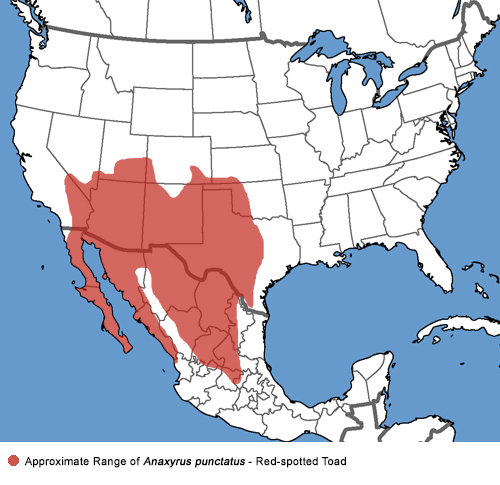 |
| Elevational Range |
From below sea level in Death Valley and in the Imperial Valley to 7,200 ft. (2,200 m.) (Stebbins, 2003)
|
| Notes on Taxonomy |
Formerly included in the genus Bufo. In 2006, Frost et al replaced the long-standing genus Bufo in North America with Anaxyrus, restricting Bufo to the eastern hemisphere. Bufo is still used in most existing references.
Alternate and Previous Names (Synonyms)
Bufo punctatus - Red-spotted Toad (Stebbins 1966, 1985, 2003, Stebbins & McGinnis 2012)
Bufo punctatus - Desert Toad (Stebbins 1954)
Bufo punctatus - Spotted Toad (Belding's Toad, Canyon Toad, Red-spotted Toad)
Bufo punctatus - Spotted Toad (Storer 1925)
Bufo punctatus - Spotted Toad (Grinnell and Camp 1917)
Bufo punctatus (Baird and Girard 1852)
|
| Conservation Issues (Conservation Status) |
| None known. Widespread declines have not been reported in most of their range, including California. This toad seems to be doing well at historical localities and at sites disturbed by cattle grazing. |
|
|
Taxonomy |
| Family |
Bufonidae |
True Toads |
Gray, 1825 |
| Genus |
Anaxyrus |
North American Toads |
Tschudi, 1845 |
| Species |
punctatus |
Red-spotted Toad
|
Baird and Girard, 1852) |
|
Original Description |
Baird and Girard, 1852 - Proc. Acad. Nat. Sci. Philadelphia, Vol. 6, p. 173
from Original Description Citations for the Reptiles and Amphibians of North America © Ellin Beltz
|
|
Meaning of the Scientific Name |
Bufo - toad
Anaxyrus - Greek = A king or chief
punctatus - Latin = spotted - refers to the spotted dorsal pattern
Taken in part from Scientific and Common Names of the Reptiles and Amphibians of North America - Explained © Ellin Beltz
|
|
Related or Similar California Frogs |
A. b. halophilus
A. w. woodhousii
|
|
More Information and References |
California Department of Fish and Wildlife
AmphibiaWeb
Hansen, Robert W. and Shedd, Jackson D. California Amphibians and Reptiles. (Princeton Field Guides.) Princeton University Press, 2025.
Stebbins, Robert C., and McGinnis, Samuel M. Field Guide to Amphibians and Reptiles of California: Revised Edition (California Natural History Guides) University of California Press, 2012.
Stebbins, Robert C. California Amphibians and Reptiles. The University of California Press, 1972.
Flaxington, William C. Amphibians and Reptiles of California: Field Observations, Distribution, and Natural History. Fieldnotes Press, Anaheim, California, 2021.
Nicholson, K. E. (ed.). 2025. Scientific and Standard English Names of Amphibians and Reptiles of North America North of Mexico, with Comments Regarding Confidence in Our Understanding. Ninth Edition. Society for the Study of Amphibians and Reptiles. [SSAR] 87pp.
Samuel M. McGinnis and Robert C. Stebbins. Peterson Field Guide to Western Reptiles & Amphibians. 4th Edition. Houghton Mifflin Harcourt Publishing Company, 2018.
Stebbins, Robert C. A Field Guide to Western Reptiles and Amphibians. 3rd Edition. Houghton Mifflin Company, 2003.
Behler, John L., and F. Wayne King. The Audubon Society Field Guide to North American Reptiles and Amphibians. Alfred A. Knopf, 1992.
Robert Powell, Roger Conant, and Joseph T. Collins. Peterson Field Guide to Reptiles and Amphibians of Eastern and Central North America. Fourth Edition. Houghton Mifflin Harcourt, 2016.
Powell, Robert., Joseph T. Collins, and Errol D. Hooper Jr. A Key to Amphibians and Reptiles of the Continental United States and Canada. The University Press of Kansas, 1998.
Grismer, L. Lee. Amphibians and Reptiles of Baja California, Including Its Pacific Islands and the Islands in the Sea of Cortés. The University of California Press, 2002.
McPeak, Ron H. Amphibians and Reptiles of Baja California. Sea Challengers, 2000.
Samuel M. McGinnis and Robert C. Stebbins. Peterson Field Guide to Western Reptiles & Amphibians. 4th Edition. Houghton Mifflin Harcourt Publishing Company, 2018.
Stebbins, Robert C. A Field Guide to Western Reptiles and Amphibians. 3rd Edition. Houghton Mifflin Company, 2003.
The Reptile Database
American Museum of Natural History - Amphibian Species of the World 6.2
Bartlett, R. D. & Patricia P. Bartlett. Guide and Reference to the Amphibians of Western North America (North of Mexico) and Hawaii. University Press of Florida, 2009.
Elliott, Lang, Carl Gerhardt, and Carlos Davidson. Frogs and Toads of North America, a Comprehensive Guide to their Identification, Behavior, and Calls. Houghton Mifflin Harcourt, 2009.
Lannoo, Michael (Editor). Amphibian Declines: The Conservation Status of United States Species. University of California Press, June 2005.
Storer, Tracy I. A Synopsis of the Amphibia of California. University of California Press Berkeley, California 1925.
Wright, Albert Hazen and Anna Wright. Handbook of Frogs and Toads of the United States and Canada. Cornell University Press, 1949.
Degenhardt, William G., Charles W. Painter, & Andrew H. Price. Amphibians and Reptiles of New Mexico. University of New Mexico Press,1996.
Davidson, Carlos. Booklet to the CD Frog and Toad Calls of the Pacific Coast - Vanishing Voices. Cornell Laboratory of Ornithology, 1995.
Joseph Grinnell and Charles Lewis Camp. A Distributional List of the Amphibians and Reptiles of California. University of California Publications in Zoology Vol. 17, No. 10, pp. 127-208. July 11, 1917.
|
|
|
The following conservation status listings for this animal are taken from the July 2025 State of California Special Animals List and the July 2025 Federally Listed Endangered and Threatened Animals of California list (unless indicated otherwise below.) Both lists are produced by multiple agencies every year, and sometimes more than once per year, so the conservation status listing information found below might not be from the most recent lists, but they don't change a great deal from year to year.. To make sure you are seeing the most recent listings, go to this California Department of Fish and Wildlife web page where you can search for and download both lists:
https://www.wildlife.ca.gov/Data/CNDDB/Plants-and-Animals.
A detailed explanation of the meaning of the status listing symbols can be found at the beginning of the two lists. For quick reference, I have included them on my Special Status Information page.
If no status is listed here, the animal is not included on either list. This most likely indicates that there are no serious conservation concerns for the animal. To find out more about an animal's status you can also go to the NatureServe and IUCN websites to check their rankings.
Check the current California Department of Fish and Wildlife sport fishing regulations to find out if this animal can be legally pursued and handled or collected with possession of a current fishing license. You can also look at the summary of the sport fishing regulations as they apply only to reptiles and amphibians that has been made for this website.
This toad is not included on the Special Animals List, meaning there are no significant conservation concerns for it in California according to the Dept. of Fish and Game.
|
| Organization |
Status Listing |
Notes |
| NatureServe Global Ranking |
|
|
| NatureServe State Ranking |
|
|
| U.S. Endangered Species Act (ESA) |
None |
|
| California Endangered Species Act (CESA) |
None |
|
| California Department of Fish and Wildlife |
None |
|
| Bureau of Land Management |
None |
|
| USDA Forest Service |
None |
|
| IUCN |
|
|
|
|
|
